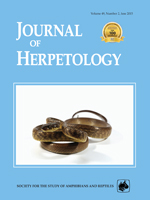We studied diet, reproduction, and sexual dimorphism in Mabuya arajara (Arajara Skink; Scincidae) in a rainforest on the slopes of the Araripe Plateau, northeastern Brazil. Diet was composed mainly of arthropods, mostly termites, when considering both number (93.5%, n = 58) and volume (58.5%, n = 58). Mabuya arajara can be classified as a forager that uses intermediate foraging techniques, as do most of its congeners. Brood size of M. arajara ranged from two to nine neonates (4.8 ± 1.7), and larger females tended to produce larger broods. The period of parturition occurs between October and December. Adult females of M. arajara were larger and heavier than adult males. There was no significant difference between the body size of males and females, but there was a significant difference in body shape between sexes. The positive relationship between brood size and female size can be considered an important correlate of the sexual selection of bigger females in Mabuya and other South American lizards in general.
How to translate text using browser tools
1 June 2015
Ecology of the Skink, Mabuya arajara Rebouças-Spieker, 1981, in the Araripe Plateau, Northeastern Brazil
Samuel C. Ribeiro,
Diego A. Teles,
Daniel O. Mesquita,
Waltécio O. Almeida,
Luciano A. dos Anjos,
Miriam C. Guarnieri
ACCESS THE FULL ARTICLE

Journal of Herpetology
Vol. 49 • No. 2
June 2015
Vol. 49 • No. 2
June 2015




